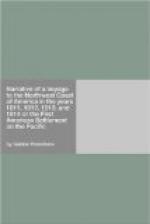Although a little less slaves than the greater part of the Indian women elsewhere, the women on the Columbia are, nevertheless, charged with the most painful labors; they fetch water and wood, and carry the goods in their frequent changes of residence; they clean the fish and cut it up for drying; they prepare the food and cook the fruits in their season. Among their principal occupations is that of making rush mats, baskets for gathering roots, and hats very ingeniously wrought. As they want little clothing, they do not sew much, and the men have the needle in hand oftener than they.
The men are not lazy, especially during the fishing season. Not being hunters, and eating, consequently, little flesh-meat (although they are fond of it), fish makes, as I have observed, their principal diet. They profit, therefore, by the season when it is to be had, by taking as much as they can; knowing that the intervals will be periods of famine and abstinence, unless they provide sufficiently beforehand.
Their canoes are all made of cedar, and of a single trunk: we saw some which were five feet wide at midships, and thirty feet in length; these are the largest, and will carry from 25 to 30 men; the smallest will carry but two or three. The bows terminate in a very elongated point, running out four or five feet from the water line. It constitutes a separate piece, very ingeniously attached, and serves to break the surf in landing, or the wave on a rough sea. In landing they put the canoe round, so as to strike the beach stern on. Their oars or paddles are made of ash, and are about five feet long, with a broad blade, in the shape of an inverted crescent, and a cross at the top, like the handle of a crutch. The object of the crescent shape of the blade is to be able to draw it, edge-wise, through the water without making any noise, when they hunt the sea-otter, an animal which can only be caught when it is lying asleep on the rocks, and which has the sense of hearing very acute. All their canoes are painted red, and fancifully decorated.




